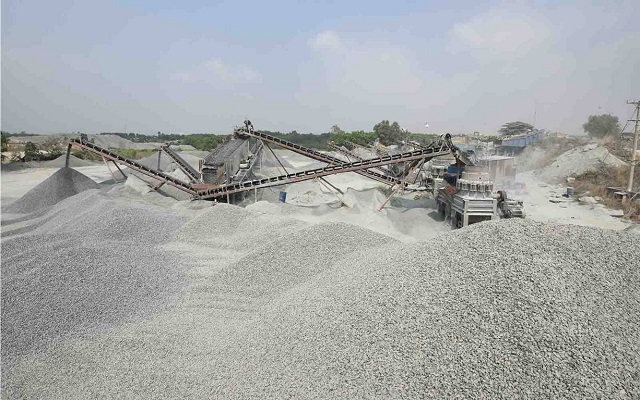
Review and evaluate mineral resources and expedite the process of bringing licensed mines into operation to timely serve key national projects – Photo: Construction Newspaper
|
Rising sand and stone prices
Specifically, steel prices rose by an average of VND 100-270 per kg depending on the type and region, a 1.2% increase compared to May. Asphalt prices surged by VND 200 per kg, marking a 0.16-0.33% increase from the previous month. The surge in asphalt prices can be attributed to the impact of rising fuel prices and transportation costs.
Cement prices remained stable, showing no fluctuation from the previous month. Cement production lines are capable of meeting domestic consumption demands and exports to foreign markets. Despite increased production costs, manufacturers must maintain a balance to attain profitability due to ample supply.
Construction sand prices witnessed a steep increase of 29.95-58.45% in various regions compared to May 2025. The Institute of Construction Economics attributes this surge in prices to heightened construction demands, scarce supply, and the temporary suspension of licensed sand mines for multiple reasons, including license expiration, erosion, and overlap. Notably, central provinces rely primarily on natural sand sources without crushing stations.
Construction stone prices rose by 7.3-11.11% compared to May 2025.
This increase can be attributed to heightened construction demands and the impact of rising construction material prices (construction sand). Localities lacking natural sand resources have resorted to using crushed sand for construction, particularly in the northern and southern regions.
“Overall, in June, construction material prices for cement, steel, and asphalt remained stable, with minimal fluctuations from the previous month. However, sand and stone prices surged significantly. Due to volatile material prices, the value of various construction projects increased by 0.68-3.14% compared to the previous month,” remarked the Institute of Construction Economics.
Material scarcity
Evidently, the scarcity of construction materials has significantly impacted the progress of key national projects.
Mr. Nguyen Tien Viet, Deputy General Director of the Vietnam Airports Corporation (ACV), shared that as of June 10, the total volume of stone supplied to the Long Thanh Airport project reached approximately 1.38 million cubic meters, while the registered demand for the entire year stands at nearly 4.92 million cubic meters, leaving a shortfall of over 3.54 million cubic meters. Currently, the stone supply rate is approximately 9%.
As the contractor for the project to upgrade and expand Nguyen Tuân Street in Hanoi, a representative of HUGIA Investment and Development Joint Stock Company revealed that construction material prices have risen by 15-20% compared to the previous month, especially stone and sand, causing significant challenges due to increased costs.
According to this enterprise, the price of construction stone and sand delivered to the site ranges from VND 470,000 to VND 500,000 per cubic meter, but these materials are still scarce. To ensure the project’s progress, the contractor must accept the high prices.
Expediting the licensing process for mineral exploitation
Regarding the supply of materials for key projects in the South, on June 26, the authorities of Dong Nai province held a meeting with relevant units to discuss the allocation of minerals for these projects. This includes significant projects such as the Long Thanh Airport, Bien Hoa – Vung Tau Expressway, and Ho Chi Minh City Ring Road 3.
At this meeting, the Dong Nai Department of Agriculture and Environment shared that the province has granted licenses for most of the proposed sand and gravel mines to ensure a sufficient supply of materials for the construction projects. Moreover, the demand for fill material has been largely met, allowing contractors to accelerate the construction process.
Concerning the 50% increase in exploitation capacity as per Resolution No. 168/NQ-CP dated June 11, 2025, Dong Nai has 14 operational stone mines that meet the requirements and have applied for this increase. If approved, these mines can provide an additional 5.2 million cubic meters of stone from now until the end of the year, sufficiently meeting the demands of key projects in the province and the Southern region.
According to the Vietnam Building Materials Association, construction material prices in the second half of 2025 will continue to be influenced by various factors, including financial policies, supply and demand imbalances, rising energy costs, and fluctuations in the real estate market. Enterprises should proactively secure stable sources of supply and increase material reserves for their projects to mitigate risks associated with price fluctuations.
Many experts believe that effective solutions require a comprehensive, synchronized, and consistent strategy across central and local levels rather than relying on individual efforts. Firstly, it is necessary to review and evaluate mineral resources and expedite the process of bringing licensed mines into operation. Simultaneously, complete the auction procedures for qualified mines to ensure a timely supplement to the supply.
Furthermore, to mitigate the negative impact of rising material prices, investors and construction contractors should establish design and construction standards that optimize material usage, reduce waste, and align with Vietnam’s climatic conditions. This includes encouraging optimal design that avoids excessive height, thick covering materials, and concrete components.
Additionally, promoting the use of recycled materials, such as fly ash from thermal power plants, recycled aggregates from demolished concrete, and recycled plastics, can help reduce the demand for traditional construction materials and alleviate the “supply falling short of demand” situation.
– 19:52 07/01/2025
















